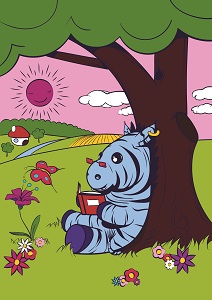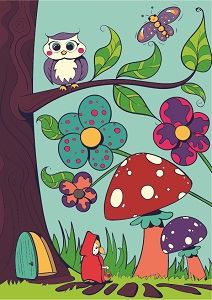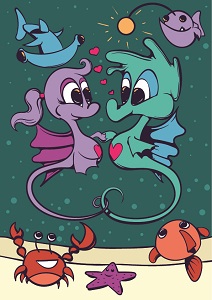Special Feature: Products Sally Recommends
The Beautiful Journey in Childhood: Coloring, Drawing, Growing
 A child coloring, concentrated on a little table, surrounded by coloring pencils and pieces of paper is one of the purest images that one could imagine. Creativity drives the little one into a realm full of possibilities where he or she can construct out drawing and color. This natural state of concentration in the realm of imagination is powerful, powerful enough to influence the development of the child, powerful enough to boost cognitive, physical and emotional development as well as self-trust and social skills. It is a tool that can be wielded by the parents in the educational process themselves, drawing and coloring being extraordinary forms of expression ready to be emphasized, ready to be enhanced.
A child coloring, concentrated on a little table, surrounded by coloring pencils and pieces of paper is one of the purest images that one could imagine. Creativity drives the little one into a realm full of possibilities where he or she can construct out drawing and color. This natural state of concentration in the realm of imagination is powerful, powerful enough to influence the development of the child, powerful enough to boost cognitive, physical and emotional development as well as self-trust and social skills. It is a tool that can be wielded by the parents in the educational process themselves, drawing and coloring being extraordinary forms of expression ready to be emphasized, ready to be enhanced.
Across centuries the manifestation of art in its numerous forms has made our civilizations tremble and progress at a spectacular pace. In the following ideas we will showcases pieces of art that will surface in one’s childhood to sculpt that child and shape it for the better.
The Interpretation and Usage of Shapes
At the early age of only two or three years old the little one starts recognizing shapes in their primitive shape: squares, circles and triangles. Around the age of three, indirectly, a child will start associating these primitives in simple compositions to what Kelog entitled “aggregates”, the formation of drawing that uses primitive shapes. The intention of resembling the reality and the usage of primitive surfaces from the little one’s need to create a connection with the loved ones with our realm, is highlighted especially as in the first representations the child portrays the family, the loved ones are represented with circles and lines. The family portrait is one of the first drawing heirlooms to appear on the fridge, one of the most loved drawings according to parents.
Scribbling
 Scribbling appears early, around the age of 18 months a child starts scribbling, prior primitive circles the simple process of pushing coloring pencils on a piece of paper raises the interest of the little one. This early action improves the muscle coordination as well as finger and wrist movement. Scribbling is an important exercise regardless of outcome, the form of expression comes naturally to a child and through practice the little one gains control, connects the mind with the hand and fine tunes motor skills. As any form of expression, scribbling aids the little one, promotes social interaction, and scribbling can tie connections.
Scribbling appears early, around the age of 18 months a child starts scribbling, prior primitive circles the simple process of pushing coloring pencils on a piece of paper raises the interest of the little one. This early action improves the muscle coordination as well as finger and wrist movement. Scribbling is an important exercise regardless of outcome, the form of expression comes naturally to a child and through practice the little one gains control, connects the mind with the hand and fine tunes motor skills. As any form of expression, scribbling aids the little one, promotes social interaction, and scribbling can tie connections.
Simplify and Conceptualize
A child of three to four years old attempts to get a better grasp on reality in his drawings and through over-simplification, through conceptualization, the child manages to recreate natural landscapes, recreate cities, and portray the family. The common elements simplified are taking people, homes, trees, birds, clouds and a smiling sun. By associating these elements, beautiful settings are born, scenes full of meaning recreate our reality. The ability to conceptualize is very important later in life and through drawing one can exercise early. The adult mind uses the trick everyday, simplifies tasks over a week in a few seconds to get a better grasp on his or her schedule.
Depicting the Reality
 An important stage in the children’s drawings is titled the “concrete operational thought “; this refers to a child’s intent of depicting the reality in a realistic manner. At this point creativity falls into second place as reality takes over with its materials, proportions and perspective; this translates in a far higher level of detail, it is translated into line weight, texture, shading. This step surfaces around the age of 9 and the attention of a mature mind in this process could be highly beneficially, this step being rather difficult and potentially-harmful for self-trust on one’s artistic chain of thought.
An important stage in the children’s drawings is titled the “concrete operational thought “; this refers to a child’s intent of depicting the reality in a realistic manner. At this point creativity falls into second place as reality takes over with its materials, proportions and perspective; this translates in a far higher level of detail, it is translated into line weight, texture, shading. This step surfaces around the age of 9 and the attention of a mature mind in this process could be highly beneficially, this step being rather difficult and potentially-harmful for self-trust on one’s artistic chain of thought.
A young artist simply needs encouragement and support; even a seasoned artist’s most important form of recognition is attention. We’ve mentioned a few simple tricks below; these ought to encourage the little minds in their creative endeavors:
Be supportive, do not critique. Regardless of circumstance, discouragement is not allowed as it can easily distress the creative drive of a young mind, there simply isn’t room for it. Invite children to be communicative, to talk about their drawing, about their concept and do your best to help them develop this even more in an educative manner.
Encourage all artistic endeavors. In the realm of art there is no dark corner, whether drawing, coloring or painting, a parent ought to encourage every effort that can help a pure mind. Be present and supportive.
Be prepared for the unpredictable. Adorably creative and without a schedule, children’s creative drive can surprise us in unexpected moments. Every burst of creativity and energy ought to be channeled on the canvas or on the playground. Be prepared and be supportive, these drives will not burst beyond a certain age, from them growth follows in a beautiful, creative action.
Art is a way of life. A beautiful and joyful way of life. Encourage it to the fullest. What do you think? We would love to hear your opinion on the subject and the cool drawings illustrated.
Note: This information was accurate when it was published. Please be sure to confirm all rates and details directly with the businesses in question before making your plans.



